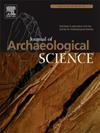Facial approximation of a Late Pleistocene human fossil in the Yahuai Cave, southern China
IF 2.6
1区 地球科学
Q1 ANTHROPOLOGY
引用次数: 0
Abstract
An almost complete human cranium, alongside a partial mandible dating to approximately 16,000 BP, was discovered in the Yahuai (YH) Cave in the Guangxi Zhuang Autonomous Region, southern China. The estimation of facial appearance has captivated both the academic community and the general public, potentially influencing perceptions of the characteristics and evolutionary history of Homo sapiens. The aim of this research was to explore a computerized method integrating geometric morphometrics and three-dimensional (3D) computer graphics to: 1) examine the morphological variations of the YH skull in comparison to contemporary humans; 2) estimate 3D facial appearance using various facial soft tissue thickness depths and the facial morphology of contemporary humans; and 3) capture morphological variations in the approximated face to provide insights into the facial traits of the Late Pleistocene individual. The results indicate that the YH skull is relatively distinct from contemporary human skulls, and this is reflected in morphological dissimilarities in the approximated face. We discuss the methods involved in computerized facial approximation, which has the potential to contribute to estimating the facial appearances of other Late Pleistocene human skulls.
中国南方雅怀洞晚更新世人类化石的面部近似
在中国南部广西壮族自治区的雅怀洞发现了一个几乎完整的人类头盖骨,以及一块可追溯到大约16000年前的部分下颌骨。对面部外貌的估计吸引了学术界和公众,潜在地影响了人们对智人特征和进化史的看法。本研究的目的是探索一种整合几何形态测量学和三维(3D)计算机图形学的计算机方法,以:1)比较YH头骨与当代人类的形态变化;2)利用不同的面部软组织厚度深度和当代人的面部形态估计三维面部外观;3)捕获近似面部的形态变化,以深入了解晚更新世个体的面部特征。结果表明,YH头骨与当代人类头骨相对不同,这反映在近似面部的形态差异上。我们讨论了计算机面部近似所涉及的方法,这有可能有助于估计其他晚更新世人类头骨的面部外观。
本文章由计算机程序翻译,如有差异,请以英文原文为准。
求助全文
约1分钟内获得全文
求助全文
来源期刊

Journal of Archaeological Science
地学-地球科学综合
CiteScore
6.10
自引率
7.10%
发文量
112
审稿时长
49 days
期刊介绍:
The Journal of Archaeological Science is aimed at archaeologists and scientists with particular interests in advancing the development and application of scientific techniques and methodologies to all areas of archaeology. This established monthly journal publishes focus articles, original research papers and major review articles, of wide archaeological significance. The journal provides an international forum for archaeologists and scientists from widely different scientific backgrounds who share a common interest in developing and applying scientific methods to inform major debates through improving the quality and reliability of scientific information derived from archaeological research.
 求助内容:
求助内容: 应助结果提醒方式:
应助结果提醒方式:


